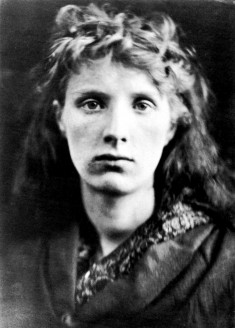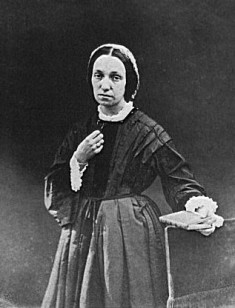| Julia Margaret Cameron | |
|---|---|
 |
|
| Photographer | |
| Specialty | Celebrity portraits |
| Born | June 11, 1815 Calcutta, British India |
| Died | Jan. 26, 1879 (at age 63) Kalutara, British Ceylon |
| Nationality | British |
Julia Margaret Cameron was a British photographer. Despite the shortness of her career, which lasted for not much more than a decade, she was highly influential, especially in the development of portrait photography.
She was also a pioneer in the control of the intellectual property relating to her photographs, making sure that the copyright office was notified of each one she took. Cameron specialized in legendary themes and in photographing the celebrities she came into contact with.
Early Years
Cameron was born in Calcutta, India, on June 11, 1815. After a straightforward education in France, she spent another decade in India, marrying a much older man. After his retirement, the family went on to London, which was the first time she had lived in England.
Beginning a Career
Her sister owned a popular salon that was frequented by well-known writers and artists of the time. When Cameron was 48, he was given a camera as a gift. She was so taken by its possibilities that she resolved to become a photographer, despite having had no formal training. She asked almost everyone she knew to pose for her, such as some of her sister’s connections, which included the likes of Sir John Herschel and Alfred, Lord Tennyson.
Photography Style
Cameron claimed that Italian Renaissance artists such as Raphael and Michelangelo inspired her in her work. She generally employed a slightly defocused style, and the fuzzy appearance of some of the resulting portraits drew derision from some of her contemporaries.
Cameron herself was unrepentant, suggesting that what she called “differential focus” made the pictures she created seem more artistic. She also considered spirituality important, creating a short series of portraits based on the life of Christ. Again, the somewhat blurred look was prominent, especially in flowers surrounding the model playing Jesus, which represented the Passion.
Most Famous Works
Despite the defocused style she adopted, Cameron nevertheless came under some criticism for the way in which she showed strong emotion in her Jesus series. One picture in particular, in which Christ is shown displaying noticeable resentment, went against the Victorian sense of the Messiah as meek and mild.
Cameron was also unafraid to break other societal taboos of the age. She made a famous photo recreating an imaginary scene in the life of Beatrice Canci. This was a woman who had been involved in a major scandal in which she had had an incestuous relationship with her father before plotting to kill him with her mother.
Later Years and Death
 Cameron’s studio was extremely modest, being originally a chicken coop. Nevertheless, she drew intense emotion from her subjects. They were never portrayed smiling or laughing, but were frequently shown with solemn, almost resigned looks on their faces.
Cameron’s studio was extremely modest, being originally a chicken coop. Nevertheless, she drew intense emotion from her subjects. They were never portrayed smiling or laughing, but were frequently shown with solemn, almost resigned looks on their faces.
She would often swap the clothing of rich and poor subjects in order to separate inner beauty from the outer trappings of class and wealth. However, by the 1870s, her work, although increasingly popular, was being hampered by her family’s financial problems. With no means of support in England, she was forced back to Ceylon. She continued to work, but very little has survived from this period. She died of a fever on January 26, 1879.